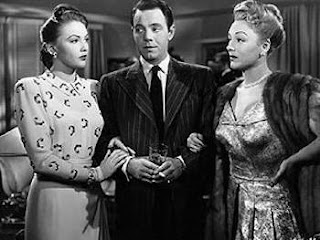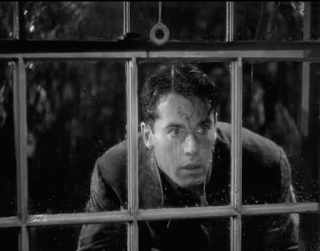 |
| John Payne, Lee Van Cleef, Neville Brand, Preston Foster, "Kansas City Confidential" (1952). |
By Paul Parcellin
Everything seemed to come together for Phil Karlson in the 1950s. It was an era in which his talent, energy and unique sensibilities were made to order for a public with an insatiable appetite for raw, gritty crime films. It was in that period that he directed some of the decade’s most essential noirs. Prior to that he’d cranked out dozens of titles beginning in the mid 1940s under the banners of Monogram (he shot several Bowery Boys and Charlie Chan films there), Eagle-Lion and other Poverty Row operations. Some might remember his two lightweight spy spoofs of later years, “The Silencers” (1966) and “The Wrecking Crew” (1968), both starring Dean Martin — although, he’d probably wish that you wouldn’t. He continued to work over several decades but didn’t strike pay dirt until the release of his revenge fantasy “Walking Tall” (1973). It was his biggest and most commercially successful film and it made him rich. Otherwise, he was mostly mired in the B-movie bush league for the remainder of his career.
But two decades before “Walking Tall,” the Chicago-born Karlson began work on a string of crime movies that would influence future generations of filmmakers.
His uncompromising narratives, short, action filled scenes and great attention to detail helped pave the way for filmmakers seeking to challenge the traditional Hollywood conventions and explore the darker aspects of human nature. Directors such as Martin Scorsese, Quentin Tarantino, and John Woo have all acknowledged his impact on their own filmmaking careers. Scorsese, in particular, cited Karlson's "The Phenix City Story" (1955) as a major inspiration for his seminal film "Mean Streets" (1973).
Karlson grew up in a working-class family in Chicago and developed an affinity for storytelling and filmmaking at a young age. He attended local film screenings and immersed himself in the world of cinema. His passion eventually led him to pursue a career in the film industry. While studying law he got a job as a prop man at Universal Studios to make ends meet during the Great Depression.
 |
| Phil Karlson. |
In the 1930s he began working as an editor for various film studios. It was during this time that he gained invaluable experience and insights into the technical aspects of filmmaking. This early exposure would shape his later directorial style and attention to detail.
As Karlson parlayed his editing experience into directing gigs, he brought a distinct sensibility to his films. His works often explore the dark underbelly of society and tell their stories in a blunt, no-nonsense manner that avoids extravagant visuals and focuses on raw emotional impact.
One of the defining themes in his films is the exploration of crime and its consequences. He had a keen eye for depicting the complexities of human nature, delving into the psychological motivations of his characters. This was exemplified in films like "Kansas City Confidential" (1952) and "99 River Street" (1953), where he portrayed flawed protagonists grappling with the consequences of their actions.
Karlson had a knack for working with actors and bringing out their best performances. He had a successful partnership with actor John Payne, with whom he collaborated on multiple projects. In addition to his noirs, he worked on a variety of movie genres: romances, comedies, musicals, westerns and war pictures. But it’s his influential noirs, shot between 1952-’57, that inspired new generations of directors making crime films. Here’s a rundown of his work:
 |
| "Kansas City Confidential" (1952). |
A masked gang of armored car robbers, identities hidden from each other, frame delivery driver Joe Rolfe (John Payne) for their crime. But Rolfe trails them to their rendezvous point, intending to infiltrate the crew and bust them up. A taut caper followed by a well-paced contest of nerves among desperate characters. Note that the story unfolds in a virtual cloud of smoke. In nearly every scene cigarettes, pipes and cigars are nervously, thoughtfully and dramatically lit and puffed on — a sure sign that we’re watching noir. Tarantino’s “Reservoir Dogs” (1992) is thought to be inspired in part by “Kansas City Confidential.”
 |
| John Derek, Broderick Crawford, "Scandal Sheet" (1952). |
Newspaperman Mark Chapman (Broderick Crawford) has a past he'd like to forget but his wife won't allow it. He gets into a bind and his reporters begin nipping at his heels — they don't know that the boss is the one they're chasing. Based on a Samuel Fuller novel, “Scandal Sheet” is all about making it big by printing the sleaziest rag in town. News hacks come within millimeters of breaking the law just to get a sensational story. Everyone’s fueled on adrenaline, booze and black coffee, talking at a fast clip and firing off wise-guy rejoinders. Chapman’s paper sponsors a lonely hearts soiree. The cynical, exploitive idea behind the parties is to corner a pair of lovebirds who just met and get them to tie the knot in front of the crowd. Meanwhile, a bit of Chapman’s dirty laundry may be about to be aired and it won’t be pretty.
 |
| Jack Lambert, John Payne, "99 River Street" (1953). |
Punched out boxer Ernie Driscoll (John Payne) takes a beating in and out of the ring in "99 River Street." A former heavyweight contender, he drives a cab and is as a doormat for nearly every bully he meets. When his girl turns up dead it looks like he's going to take the fall. As in “Kansas City Confidential,” Payne plays another falsely accused outsider who has been dealt a rotten hand and must redeem himself in society’s eyes. Panned by the New York Times when it was released, the film received more favorable favorable treatment in later years. Martin Scorsese and film critic Jonathan Rosenbaum both chose to include “99 River Street” on lists of best and favorite films.
 |
| John McIntire, "The Phenix City Story" (1955). |
Crime and vice majordomo Rhett Tanner (Edward Andrews) has a corrupt Alabama town under his thumb. Local mouthpiece Pat Patterson is urged to run for the A.G. seat, but who wants that job? When violence visits the reformers he reconsiders his neutral position. But the mob doesn’t take kindly to the threat of a law and order attorney general in their midst. Based on a true story, “The Phenix City Story” portrays the struggles of honest folks who wrestle with their conscience and decide to take positive steps despite the threat of violence to themselves and their families. Ever the stickler for detail, Karlson had his actor wear the clothes belonging to the murder victim on whom the story is based.
 |
| William Conrad, Brian Keith, "5 Against the House" (1955). |
Korean War veterans studying at college decide to rob a casino as a lark. Ronnie (Kerwin Mathews), a rich kid who doesn’t need the money, wants to prove he’s smart enough to mastermind the perfect crime. It’s all just a prank by overgrown school boys — they plan to leave the stolen loot where the casino can recover it. But Brick (Brian Keith), who suffered a head wound in the war, is a wild card in this shaky caper. The rest of the gang is in various stages of arrested development, picking up where they left off before trudging off to Korea. But they soon find that swiping a casino’s money is not mere fun and games.
 |
| Ginger Rogers, Brian Keith, Edward G. Robinson, "Tight Spot" (1955). |
U.S. attorney Lloyd Hallett (Edward G. Robinson) offers good-girl inmate Sherry Conley (Ginger Rogers) a chance to bust out if she finks on a mobster. Lt. Vince Striker (Brian Keith) acts as her bodyguard — and soon things heat up between them. Rogers gets the chance to play against type in the role of Sherry, the brassy, fast talking blonde trying to get all she can from the prosecutor who wants her testimony. It’s a risky ploy for her. The last witness never made it to the courtroom, and odds are that Sherry won’t do much better. Call this one a noir with a hint of screwball comedy.
 |
| Richard Conte, Patricia Donahue, Jane Easton, Richard Bakalyan, "The Brothers Rico" (1957). |
The happily married Eddie Rico (Richard Conte) owns a laundry business in Florida and seems to have the world on a string. But his past connection to organized crime as well as family ties threaten to pull him back into the syndicate. A gangster demands that he provide a hideout for a syndicate hitman. Worse news, still, Eddie learns that his two brothers, Johnny (James Darren) and Gino (Paul Picerni), both of whom are still involved with the mob, have disappeared. Prolific Belgian novelist Georges Simenon wrote the book on which the film is based. Studio executives finessed the novel’s downbeat ending and tacked on a happier conclusion, much to the disappointment of the author’s fans and to Karlson, too.
By the time that “The Brothers Rico” came to the screen it was near the end of the road for the classic noir era. The following year Orson Welles would release “Touch of Evil” (1958), which many consider the final classic noir. Karlson continued to direct films and television thereafter but never equalled the level of artistic excellence he achieved in the 1950s. Still, his handful of films noir made a mark on the genre and continue to influence today’s filmmakers.
















